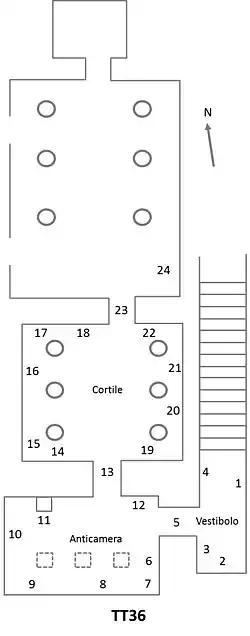| Theban tomb TT36 | |
|---|---|
| Burial site of Ibi | |
 | |
| Location | El-Assasif, Theban Necropolis |
| Discovered | 26th dynasty |
| Ibi in hieroglyphs | ||||
|---|---|---|---|---|
| Era: Late Period (664–332 BC) | ||||
The Theban Tomb TT36 is located in El-Assasif, part of the Theban Necropolis, on the west bank of the Nile, opposite to Luxor.[2] It is the burial place of the ancient Egyptian Ibi, who was "Chief Steward of the Adorer of the God" (Nitoqret I), during the reign of Psamtik I during the 26th dynasty.[3]
Decoration and layout
The tomb decoration in this tomb was copied from the tomb of another noble called Ibi, from the Old Kingdom cemetery at Deir el-Gabrawi. This is typical of the Saite Period, which tended to echo the decoration of previous periods of Egyptian history.
The tomb is entered via a flight of steps that run parallel to the main axis. At the foot of these steps is an antechamber, which is decorated with scenes of Ibi adoring Ra-Horakhty. There is also a false door, echoing Old Kingdom decoration. A doorway leads from the middle of the right hand wall into what was a pillared hall (these pillars have since been destroyed). This room shows Ibi dressed as an ancient noble, watching the work of craftsmen and dancing girls.[2]
The right-hand wall has a doorway that leads into what was once an open court. This is decorated on the right-hand wall with a hunting scene, and on the left-hand wall Ibi and his father sit whilst offerings are placed in tables in front of them. From this hall several chambers lead off, one to the burial-shaft. These chambers have Ptolemaic paintings, and show that the tomb was reused at this time.
See also
References
- ↑ Bertha Porter, Rosalind L. B. Moss, Ethel W. Burney: Topographical Bibliography of Ancient Egyptian Hieroglyphic Texts, Reliefs, and Paintings. I. The Theban Necropolis. Part 1. Private Tombs. Second Edition, revised and augmented. Griffith Institute/ Ashmolean Museum, Oxford 1970, ASIN B002WL4ON4 pp. 63–68, Map IV. (PDF; 21,9 MB); from The Digital Topographical Bibliography.
- 1 2 Baikie, James (1932). Egyptian Antiquities in the Nile Valley. Methuen. pp. 564–566.
- ↑ Rice, Michael (1999). Who's Who in Ancient Egypt. Routledge. p. 74.